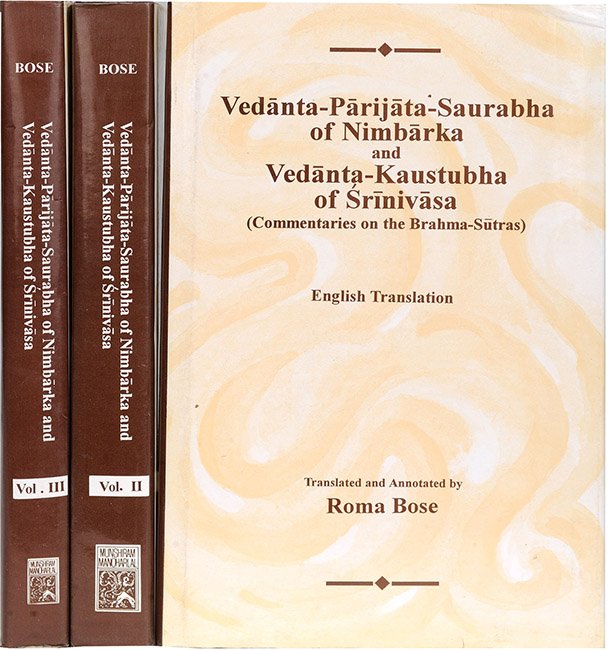Brahma Sutras (Nimbarka commentary)
by Roma Bose | 1940 | 290,526 words
English translation of the Brahma-sutra 3.3.20 (prima facie view), including the commentary of Nimbarka and sub-commentary of Srinivasa known as Vedanta-parijata-saurabha and Vedanta-kaustubha resepctively. Also included are the comparative views of important philosophies, viz., from Shankara, Ramanuja, Shrikantha, Bhaskara and Baladeva.
Brahma-Sūtra 3.3.20 (prima facie view)
English of translation of Brahmasutra 3.3.20 by Roma Bose:
“On account of connection, so elsewhere also.”
Nimbārka’s commentary (Vedānta-pārijāta-saurabha):
Just as the Śāṇḍilya-vidyās are identical, and through connection with them, there is the combination of special features, “so” on account of their connection with the same vidyā through the introductory passage: “Truth is Brahman” (Bṛhadāraṇyaka-upaniṣad 5.4.1[1]), the two names, mentioned in the scriptural texts: “His secret name is ‘Day’—this in reference to the presiding deities” (Bṛhadāraṇyaka-upaniṣad 5.5.3[2]), “His secret name is ‘I’—this in reference to the self” (Bṛhadāraṇyaka-upaniṣad 5.5.4[3]), are to be combined,—this is the prima facie view.
Śrīnivāsa’s commentary (Vedānta-kaustubha)
Now, having suggested a prima facie view, viz. Just as owing to the identity of the objects to be meditated on, there is combination of attributes in the Śāṇḍilya-vidyā, so there is combination of the names in the meditation on the true Brahman also, having the mystic words[4] for His body,—(the author) disposes of it in two aphorisms.
In the Bṛhadāraṇyaka, we read, beginning: “Truth is Brahman” (Bṛhadāraṇyaka-upaniṣad 5.4.1), and continuing: “Now the real is the yonder sun. The Person who is there in that orb and the Person who is here in the right eye” (Bṛhadāraṇyaka-upaniṣad 5.5.2) and so on. Here, having declared that the true Brahman is the object to be meditated on—in the orb of the sun as well as in the right eye—as having the mystic words as His body in the passage: “Bhūr is his head, Bhuvar is his arms, Svar is his feet” (Bṛhadāraṇyaka-upaniṣad 5.5.3), the text teaches two secret names as complementary to the meditation. Here, the true Brahman, the support of the sun and the support of the eye, is successively stated to have the name ‘Day’ and the name ‘I’, thus: “His secret name is ‘Day’—this in reference to the presiding deities” (Bṛhadāraṇyaka-upaniṣad 5.5.3), “His secret name is ‘I’—this in reference to the self” (Bṛhadāraṇyaka-upaniṣad 5.5.4).
Here the doubt is as to whether the stated names are each to be meditated on singly in its own place (i.e. where mentioned), or whether each is to be meditated on in both the places as combined with the other. Just as in the Śāṇḍilya-vidyā there is a mutual combination of attributes on account of their connection with an identical vidyā, “so elsewhere too”, i.e. in the case of the orb of the sun and the eye, the two names are to be mutually combined in both the places “on account of their connection” with an identical vidyā,—this is the meaning of the prima facie aphorism.
Comparative views of Baladeva:
This is sūtra 21 in his commentary. He begins a new adhikaraṇa here (five sūtras), concerned with the worship of the aveśāvatāras or God-possessed souls like Nārada and so on. The question is whether they too are to be meditated on as possessed of the attributes of the Lord Himself. This is the prima facie view: “On account of (their intimate) connection (with the Lord Himself), in others also (i.e. the God-possessed souls), (are to be meditated on) thus, (i.e. as possessed of the attributes of the Lord”.[5]
Footnotes and references:
[1]:
Quoted by Śaṅkara, Rāmānuja, Bhāskara and Śrīkaṇṭha.
[2]:
Quoted by Śaṅkara, Rāmānuja, Bhāskara and Śrīkaṇṭha.
[3]:
Op. cit.
[4]:
Viz. Bhūr, Bhuvar and Svar.
[5]:
Govinda-bhāṣya 3.3.21, p. 147, Chap. 3.
